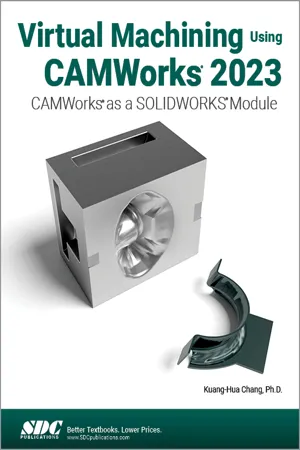
Virtual Machining Using CAMWorks 2023
CAMWorks as a SOLIDWORKS Module
- English
- PDF
- Available on iOS & Android
About this book
- Teaches you how to prevent problems, reduce manufacturing costs, shorten production time, and improve estimating
- Designed for users new to CAMWorks with basic knowledge of manufacturing processes
- Covers the core concepts and most frequently used commands in CAMWorks
- Incorporates cutter location data verification by reviewing the generated G-codes
This book is written to help you learn the core concepts and steps used to conduct virtual machining using CAMWorks. CAMWorks is a virtual machining tool designed to increase your productivity and efficiency by simulating machining operations on a computer before creating a physical product. CAMWorks is embedded in SOLIDWORKS as a fully integrated module. CAMWorks provides excellent capabilities for machining simulations in a virtual environment. Capabilities in CAMWorks allow you to select CNC machines and tools, extract or create machinable features, define machining operations, and simulate and visualize machining toolpaths. In addition, the machining time estimated in CAMWorks provides an important piece of information for estimating product manufacturing cost without physically manufacturing the product.
The book covers the basic concepts and frequently used commands and options you'll need to know to advance from a novice to an intermediate level CAMWorks user. Basic concepts and commands introduced include extracting machinable features (such as 2.5 axis features), selecting machine and tools, defining machining parameters (such as feed rate), generating and simulating toolpaths, and post processing CL data to output G-codes for support of CNC machining. The concepts and commands are introduced in a tutorial style presentation using simple but realistic examples. Both milling and turning operations are included.
One of the unique features of this book is the incorporation of the CL (cutter location) data verification by reviewing the G-codes generated from the toolpaths. This helps you understand how the G-codes are generated by using the respective post processors, which is an important step and an ultimate way to confirm that the toolpaths and G-codes generated are accurate and useful.
This book is intentionally kept simple. It primarily serves the purpose of helping you become familiar with CAMWorks in conducting virtual machining for practical applications. This is not a reference manual of CAMWorks. You may not find everything you need in this book for learning CAMWorks. But this book provides you with basic concepts and steps in using the software, as well as discussions on the G-codes generated. After going over this book, you will develop a clear understanding in using CAMWorks for virtual machining simulations, and should be able to apply the knowledge and skills acquired to carry out machining assignments and bring machining consideration into product design in general.
Who this book is for
This book should serve well for self-learners. A self-learner should have a basic physics and mathematics background. We assume that you are familiar with basic manufacturing processes, especially milling and turning. In addition, we assume you are familiar with G-codes. A self-learner should be able to complete the ten lessons of this book in about forty hours.
This book also serves well for class instructions. Most likely, it will be used as a supplemental reference for courses like CNC Machining, Design and Manufacturing, Computer-Aided Manufacturing, or Computer-Integrated Manufacturing. This book should cover four to five weeks of class instructions, depending on the course arrangement and the technical background of the students.
What is virtual machining?
Virtual machining is the use of simulation-based technology, in particular, computer-aided manufacturing (CAM) software, to aid engineers in defining, simulating, and visualizing machining operations for parts or assembly in a computer, or virtual, environment. By using virtual machining, the machining process can be defined and verified early in the product design stage. Some, if not all, of the less desirable design features in the context of part manufacturing, such as deep pockets, holes or fillets of different sizes, or cutting on multiple sides, can be detected and addressed while the product design is still being finalized. In addition, machining-related problems, such as undesirable surface finish, surface gouging, and tool or tool holder colliding with stock or fixtures, can be identified and eliminated before mounting a stock on a CNC machine at shop floor. In addition, manufacturing cost, which constitutes a significant portion of the product cost, can be estimated using the machining time estimated in the virtual machining simulation.
Virtual machining allows engineers to conduct machining process planning, generate machining toolpaths, visualize and simulate machining operations, and estimate machining time. Moreover, the toolpaths generated can be converted into NC codes to machine functional parts as well as die or mold for part production. In most cases, the toolpath is generated in a so-called CL data format and then converted to G-codes using respective post processors.
Frequently asked questions
- Essential is ideal for learners and professionals who enjoy exploring a wide range of subjects. Access the Essential Library with 800,000+ trusted titles and best-sellers across business, personal growth, and the humanities. Includes unlimited reading time and Standard Read Aloud voice.
- Complete: Perfect for advanced learners and researchers needing full, unrestricted access. Unlock 1.4M+ books across hundreds of subjects, including academic and specialized titles. The Complete Plan also includes advanced features like Premium Read Aloud and Research Assistant.
Please note we cannot support devices running on iOS 13 and Android 7 or earlier. Learn more about using the app.
Information
Table of contents
- Preface
- Acknowledgements
- About the Author
- Table of Contents
- Lesson 1: Introduction to CAMWorks
- Lesson 2: A Quick Run-Through
- Lesson 3: Machining 2.5 Axis Features
- Lesson 4: Machining a Freeform Surface
- Lesson 5: Multipart Machining
- Lesson 6: Multiplane Machining
- Lesson 7: Multiaxis Milling and Machine Simulation
- Lesson 8: Turning a Stepped Bar
- Lesson 9: Turning a Stub Shaft
- Lesson 10: Die Machining Application
- Appendix A: Machinable Features
- Appendix B: Machining Operations